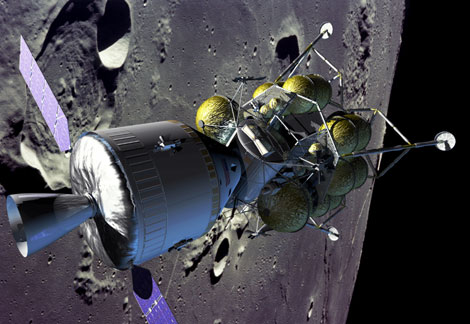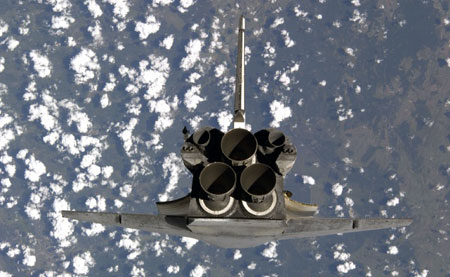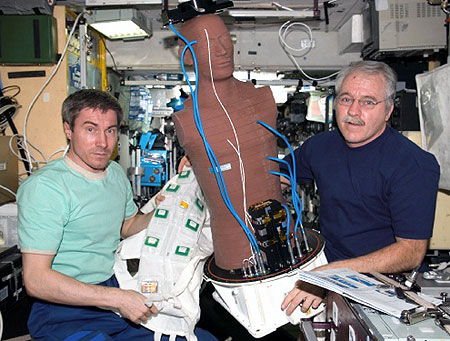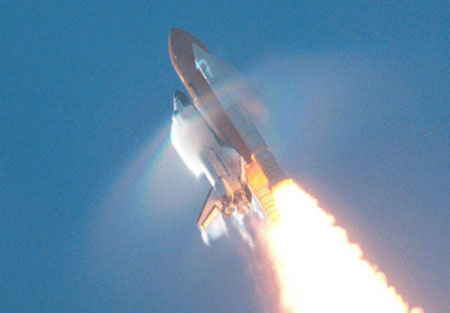
| « Party on the Gowanus | Secret CIA Prisons in Poland? » |

The most striking thing about the newly updated space exploration plan from NASA is what it leaves out. Other than the sensible decision to reuse the main engines and solid rocket boosters, it's as though the Space Shuttle never happened. Earlier proposals for a crew exploration vehicle (CEV) had shown a little stubby lifting body design, a kind of shuttle fetus, that would glide back to earth much like the current orbiter. But the latest, authorative design is an exact copy of the Apollo capsule, scaled up to hold six astronauts. Instead of coasting down on tile-protected wings, it drops on a ballistic trajectory, protected by an ablative heat shield.
Using the Apollo capsule design means NASA can build on old research data from the Apollo program while stuffing the vehicle with the latest in structural and avionics wizardry. But it also sends a not-so-subtle signal that the Shuttle era is over, and there's not much from it worth keeping.
Just in case the signal wasn't clear enough, NASA Administrator Michael Griffin even went on record to say that the Shuttle program, along with the International Space Station, was a mistake. While Griffin had made such comments before, this was the first time he has said so as head of the agency, and he was quickly forced to issue a contrite and effusive letter to his staff explaining how, when he said that that dress made their butt look fat, what he realy meant was quite different, and they they had completely misunderstood him, and that some people had misconstrued his words in the worst possible way, twisting them out of context, for which he was genuinely sorry.
The news didn't get any better when the "tiger team" analyzing the foam shedding from the Discovery launch released its TPS report (thermal protection system, no joke). The report explains, in exhaustive detail, that:
a) no one really understands how foam physics works
b) it's probably not helping to have workers stomping on it all the time during processing.
It would be easy to criticize negligent work habits for the foam shedding, but the real problem seems to be that the foam is far more fragile than anyone anticipated. When damage occurs, it's invisible and permanent. Unfortunately, the materials science of foam is in its infancy, and solutions to the problem are strictly voodoo: learn how to apply the foam with automated equipment, keep anyone from touching it more than absolutely necessary, get away from using it as soon as possible, stop hanging spacecraft on the sides of fuel tanks.

It hasn't been a good year for the Space Shuttle. Hurricanes are hitting the key Shuttle processing centers, the foam problem is intractable, and there is increasing political pressure to cut funding for the Shuttle program, along with the ISS. Even the celebrated Return to Flight resulted in a Return to Grounding before the Discovery had time to make more than a few proper orbits, and at present, the earliest possible date for a second launch has been pushed back to May 6th. This raises the interesting possibility that the Return to Flight will become an annual celebration, like Veterans' Day, as shuttles go up and are promptly grounded to fix problems that would never have been spotted without new scrutiny recommended by the previous year's investigating commission. It also raises the question of how NASA plans to get 28 Shuttle missions into space before the orbiter is officially grounded in 2010. Assuming the May launch date were to hold, orbiters would have to go up every two and a half months to meet that deadline, a pace NASA has never been able to sustain for that number of missions.
Meanwhile, up on the ISS, they're having problems of their own. Not only did they just say goodbye to the third millionaire space tourist, whose presence makes a mockery of the station as a scientific research platform, but they can't even find his digital camera, which got lost (or stolen!) sometime during his six-day stay. And it's looking less and less likely that the ISS is ever going to grow past its current, cramped configuration. There are signs that Michael Griffin is planning to cut the number of Shuttle flights down to eight (seven to supply the ISS, one to upgrade the Hubble), and possibly fewer, by instituting a procedure called serial processing. This means Shuttles would be prepared for flight one at a time, rather than by multiple ground crews, and it would limit the theoretical number of flights to two a year (still double the current rate) while drastically cutting personnel on the ground. This is very bad news for NASA's foreign partners, who have spent billions building ISS components with the understanding that NASA would shoot them into space, but it may actually be great news for the manned space program. No one can explain what the completed space station is supposed to do, after all, that justifies the enormous cost of finishing it. And it might just be possible that Griffin will assign all those redundant Shuttle workers to building the CEV.

An earlier version of the Vision for Space Exploration - NASA's long-term master plan - had been a Baroque nightmare involving something called spirals of capability (the object of an excellent critique by Zubrin), a defense-procurement concept that required five generations of equipment before the agency could land an astronaut on Mars. The spiral plan was crazy. Its sheer complexity made the Space Shuttle look like an elegant hack.
To give you just a taste, the first manned mission back to the Moon required no fewer than four closely-spaced launches, followed by four orbital rendezvous, to accomplish in eight steps what Apollo had done in two. Not only were there two distinct flavors of Moon mission, short-stay and long stay, using different equipment, but the equipment to be developed for the long Moon missions was not the equipment that would go to Mars. And the plan even anticipated a manned Mars flyby, sending a fully crewed vehicle at terrific expense all the way out to the red planet, only to turn around without landing and return to Earth. Moreover, the whole plan was infested with robots - robots to clean the space station, robots to explore the Moon, robots to do spacewalks, robots to carry space luggage. Mind you, I am not a bigot, and I have absolutely nothing against robots. But for Administrator Sean O'Keefe, the robots became a bit of a weird fixation.
O'Keefe, you may recall, was the political genius who cancelled the Shuttle mission to upgrade the Hubble telescope, the most beloved piece of scientific apparatus in the world, on the grounds that it was too dangerous to fly anywhere but to the Space Station. Since the Hubble is one of the most useful tools ever to come out of NASA, and the Hubble upgrade is the only Shuttle mission that genuinely requires a manned crew, the decision didn't go over well with anyone. But rather than back down, O'Keefe had the audacity to ask for over a billion dollars in funding to develop an alternate plan. We will save the Hubble, he said, with robots. But we must hurry.

It was a considerable relief, to have O'Keefe leave and be replaced by current administrator Michael Griffin, whose first move was to fire practically everyone, and whose second move was to get rid of spirals and robots and insist that all missions to the Moon serve as a staging ground for an expedition to Mars. The current plan has a main vehicle and lunar lander that are purposely oversized, large enough to carry a crew on a Mars mission.
The vehicles use fuels that could potentially be synthesized on Mars or the lunar surface (in a politically shrewd move, the main propellant on the CEV is ethanol, guaranteeing that the Russians can't safely piggyback on the technology). And the mission and vehicle design are strictly Apollo 2.0. The only parts of the Shuttle recycled in the system are the main engines, solid rocket boosters, and portions of the fuel tank - important components, but hardly ones that required a thirty-year detour into reusable winged space aircraft design.
The CEV program does not lay out a case for sending astronauts to Mars. It takes the goal as a given, based on a Bush policy speech endorsing the idea, which has not sat well with many politicians. They question the wisdom of spending money on space travel when the country is still struggling with expensive national disasters like Hurricane Katrina and the Bush administration. Luckily, however, the Chinese have now stepped in to give the Mars effort a political urgency that it could never acquire on the merits. If we end up on Mars in the next fifteen years, we might just have Beijing to thank for it.

Last month saw the successful launch and return to earth of a Chinese version of the Gemini program. The stated objective of the Chinese flights is to perform scientific research (the capsule carried 40 grams of frozen pig sperm), eventually constructing a Mir-like space station, but there seems little doubt that China will eventually want to shoot the Moon. A lunar landing is just within China's technical capability, and the Chinese penchant for giant prestige projects suggests that the hideous price of a moon shot is not going to be a problem.
It is likely, therefore, that the next decade will open with a Space Chase (the inevitable name), as China attempts to develop a space program from scratch faster than the United States can dust off its forty-year-old blueprints. There's something charmingly retro about it - a rematch of the great 1960's battle of ideology, using refurbished 1960's equipment. On pad 1, we have Red China, the not-so-Communist menace, flying a souped-up clone of the Soyuz; on pad 2, there's the United States, returning to flight in a tricked-out version of the Apollo. There may even be a pad 3, some kind of unholy alliance of Europeans, Russians, and Objectivist billionaires, flying a composite rocket powered by the sheer force of the market.
It's not clear how far and how fast the Chinese space program will advance, but it's hard to imagine any American politician who could allow China to build a space station, let alone try for a Moon landing, while the United States has no manned flight capability at all (the current plan for 2010-12). So it's likely we'll see a grudging increase in funding, and even an accelerated schedule for CEV development, just as long as China remains serious about its space program. And luckily for us Mars geeks, China is one of the few countries on Earth even more nationalistic than the United States, with its own superpower aspirations. Having made it this far, they are unlikely to back down, and we may have to go to Mars just to upstage them.
The focus on Mars also solves the dicey problem of what to do with the International Space Station, floating uncompleted up in its useless orbit. Suddenly all those experiments on the effect of long-duration human space flight experiments begin to make sense, and the ISS becomes a handy place to bolt things on to for component testing. Rather than a useless white elephant, the ISS will start to look like a prime development platform. Pass over the huge opportunity cost of building it, and people might even start to argue that it was a great idea to put the thing up there.
But what about the real space program - the probes and satellites that actually do the work of scientific exploration? It's harder to tell how they will fare given the current budget pressure, but it's a good guess that anything that improves our ability to loft heavy things into space - and the next-generation rocket will be a very big rocket indeed - can only be good news for space exploration. It's hard to imagine a bigger drain on the unmanned program than the current tag team of ISS and Shuttle, even in the worst funding climate. So hats off to Mike Griffin, the Chinese, and a big welcome back to the Apollo program. The next few years should be fun for everybody.
| « Party on the Gowanus | Secret CIA Prisons in Poland? » |
brevity is for the weak
Greatest Hits
The Alameda-Weehawken Burrito TunnelThe story of America's most awesome infrastructure project.
Argentina on Two Steaks A Day
Eating the happiest cows in the world
Scott and Scurvy
Why did 19th century explorers forget the simple cure for scurvy?
No Evidence of Disease
A cancer story with an unfortunate complication.
Controlled Tango Into Terrain
Trying to learn how to dance in Argentina
Dabblers and Blowhards
Calling out Paul Graham for a silly essay about painting
Attacked By Thugs
Warsaw police hijinks
Dating Without Kundera
Practical alternatives to the Slavic Dave Matthews
A Rocket To Nowhere
A Space Shuttle rant
Best Practices For Time Travelers
The story of John Titor, visitor from the future
100 Years Of Turbulence
The Wright Brothers and the harmful effects of patent law
Every Damn Thing
Your Host
Maciej Cegłowski
maciej @ ceglowski.com
Threat
Please ask permission before reprinting full-text posts or I will crush you.